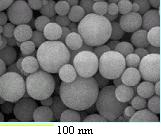NANO-SIZE POWDERS
Ultrafine powders, with sizes from a few nanometers to several microns with high surface area have important applications in the areas of materials, electronics, catalysis and analytical chemistry. In addition, Ultrafine powders may be compacted and sintered to get nanocrystalline materials which have superior mechanical, thermal and magnetic properties in many cases. Many methods are used for synthesis of nanocrystalline materials including: mechanical milling, sol-gel, electro-deposition, gas atomization, chemical vapor deposition, physical vapor deposition, aerosol processes, flame assisted deposition, laser ablation, sputtering, plasma method, and inert gas condensation. Different methods may synthesize different types of nanocrystalline materials (powders, films, bulk material).
Aerosol techniques exploit aerosols to produce films and powders with special characteristics. Aerosol techniques can be generally either gas-to-particle processes or droplet-to-particle processes. In the gas-to-particle processes, a supersaturated vapor of a condensable gaseous species is formed either as a result of chemical reactions that create new species or as the result of physical processes such as cooling that reduce the vapor pressure of condensable species. In droplet-to-particle processes, a solution is sprayed into a carrier gas, solvent evaporates, a chemical decomposition may occur and final particles are produced. In spray pyrolysis, which is in category of droplet-to-particle methods, an intraparticle reaction occurs in droplets by passing the spray droplets through a tubular furnace. A decomposition reaction occurs to produce final product. In spray drying method of droplet-to-particle methods, no reaction occurs after solvent evaporation and simply the solution is dried to give final particles. Some other methods, like freeze drying, spray-freeze drying, and melt atomization belong to the category of droplet-to-particle aerosol techniques.

Multicomponent droplet evaporation is a major process in spray methods as well as a variety of other applications like atmospheric phenomena. In spray methods, usually a multicomponent solution is sprayed into a chamber and understanding of evaporation process plays an important role on determination of particle morphology and control of properties of final product. Because of complexities there is almost no major work on theoretical and experimental investigation of multicomponent droplet evaporation in the Knudsen regime. In Knudsen regime, which is a transition regime from kinetic theory of gases to continuum theory, the concept of continuum no longer is valid and statistical mechanics should be applied. Evaporation and condensation processes, gas/particle chemical reactions, and other transport processes are strongly affected by the size of the particle compared with the mean free path of the molecules in the surrounding medium. For Kn<<1 molecular collisions are so frequent that the gas may be considered to be a continuum, but for Kn>>1 gas molecule/particle collisions predominate over molecule/molecule collisions. The intermediate regime or Knudsen regime is much less understood and has been object of extensive study in the past few decades. Much of that work has involved solution of integro-differential equation due to Boltzmann, which describes the evolution of the molecular velocity distribution function or phase space distribution function in a non-equilibrium gas system.
We are studying the effect of operating condition on nanopowder production, particle evolution, and morphology by investigating the effect of important factors on evaporation of micron-sized water-salt solution droplets and evolution of fine particles in the Knudsen regime.
METAL MATRIX POWDER PRODUCTION
PRODUCTION OF A SILICON CARBIDE PARTICULATE/ALUMINUM METAL MATRIX COMPOSITE USING CENTRIFUGAL ATOMIZATION
The motivation for this work is to develop a new technique for preparing metal matrix composites (MMCs) by injecting silicon carbide particles into molten aluminum just prior to centrifugal atomization. A centrifugal atomization apparatus has been constructed. Silicon carbide particles have successfully been injected during atomization of 6061 aluminum alloy to form a metal matrix composite powder. The composite powder contains approximately 18 Vol. percent silicon carbide and 1.2 Vol. percent voids. For efficient compacting spherical particles are preferred, however the particles formed during this experimentation were not spherical in shape. To aid in future experimental design, heat loss from the aluminum has been estimated from the point at which the aluminum leaves the furnace until the atomized droplets hit the wall of the atomization chamber. The mode of atomization has been identified as ligament formation from a toroidal rim that forms on the edge of the atomization disk. The analysis shows that by reducing the flow rate of aluminum in future experiments the mode of atomization will change to direct drop formation. This mode of atomization will produce more spherical shaped powder.
